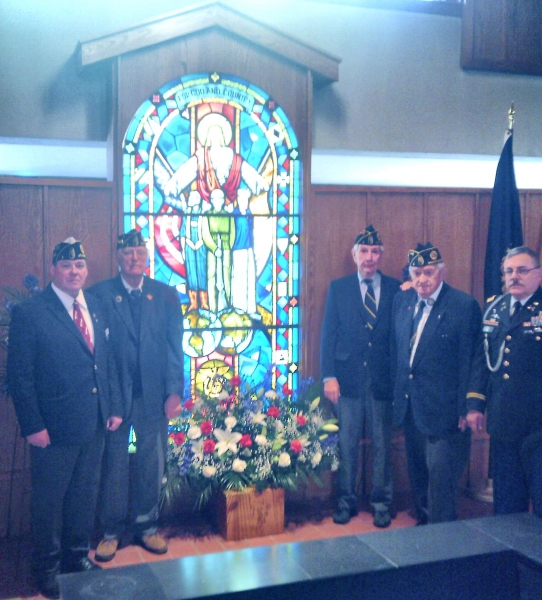
DATE: February 19, 2018
PUBLICATION: New Hampshire Union Leader (Manchester, NH)
Website: www.unionleader.com
St. Raphael the Archangel Parish unveiled a World War I memorial on Sunday, 100 years to the day that a young man who grew up in the parish became the first Manchester soldier killed in The Great War. Pvt. Henry John Sweeney died Feb. 18, 1918, when an artillery shell landed next to him and exploded in Soissons, France.
The stained-glass window features an image of Christ standing over three servicemen -- an aviator, soldier and a sailor -- with a waving American flag and the words “For God and Country” atop the arch. The Rev.Jerome Day, pastor at St. Raphael, blessed the memorial and took a few moments during Mass on Sunday morning to recognize the sacrifice made by Sweeney and other service members from the West Side parish.
Day said the window was recovered from a Chicago church that had closed. Although the asking price was initially well out of reach, it came down over the years and reached a point that was more realistic for the church’s means, he said. Day pitched his idea to the Catholic War Veterans and CWV Auxiliary, which donated the funds to bring the window to Manchester and have it restored and placed on a new wall built just north of the St. Raphael altar. After the service, Day said the fact that the 100th anniversary and the first Sunday of Lent coincided felt appropriate. “The more I thought about it, there’s a kind of simpatico between commemoration and celebration when you’re talking about something like a war and the deaths that come from it, but also talking about the sacrifice of Christ himself,” Day said. “The loss and the death are obviously not something to celebrate but the overall victory is something to celebrate.”
The parish also tracked down World War I memorabilia and set up a temporary exhibit in a room at the back of the church, where burlap sacks resembling sandbags lined the floor and display cases featured military gear including a rifle, gas mask and a special set of Rosary beads given to Catholic soldiers. “It’s just wonderful,” said Anne Kenney, whose family donated several items for the exhibit, including journals and letters written by her father, Frank Kenney, who served in World War I. Day also compiled a series of posterboards using old photographs and newspaper clippings to illustrate key moments covering the war from the assassination of Archduke Franz Ferdinand of Austria-Hungary in 1914 to the signing of the Treaty of Versailles five years later. “The point is to try and give people as they walk around and look at it a better sense of the war. As American people, sadly we have very short attention spans. We tend to forget things,” Day said.
Day said other contributions for “A Parish Goes to War: Saint Raphael in World War I” are on loan from the Manchester Historic Association and Saint Anselm College and Abbey. Parishioners strolled through the exhibit after the service before heading downstairs for a commemorative brunch honoring Sweeney and the other “lads” from St. Raphael’s who fought in World War I. Sweeney grew up on the West Side and attended the St. Raphael parish school. He was buried in France and his remains were returned to the United States in August, 1921, arriving on a train along with the remains of Cpl. Charles Andrew Vaughan, killed in the fall of 1918. A city park and the American Legion Sweeney Post 2 are named for Sweeney.
View more history for Post 2 in Manchester, NH , New Hampshire
